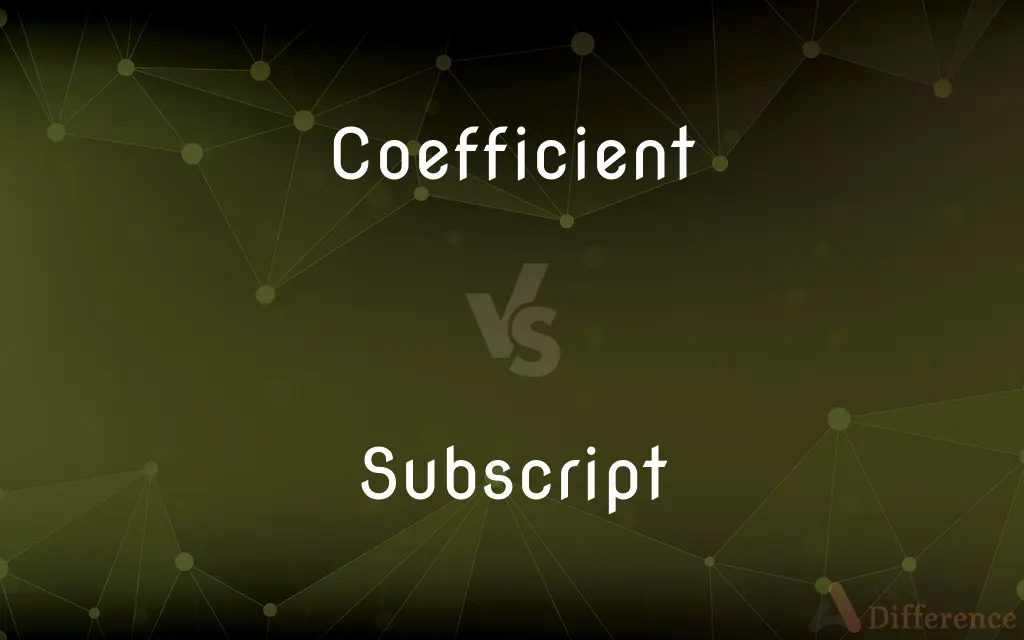Coefficient vs. Subscript — What's the Difference?
Edited by Tayyaba Rehman — By Fiza Rafique — Updated on September 22, 2023
A coefficient is a numerical or constant quantity placed before a variable in an algebraic expression to indicate multiplication. A subscript is a number, letter, or symbol written slightly below the line to specify one of several subsets of a variable.

Difference Between Coefficient and Subscript
Table of Contents
ADVERTISEMENT
Key Differences
A coefficient in mathematics is usually a numerical factor that is multiplied by a variable or variables in an equation or expression. Subscripts are often used in mathematics, as well as other fields like chemistry, to specify a particular element of a sequence, array, or set.
The coefficient is an integral part of algebraic equations, often dictating the behavior or the roots of the equation. Subscripts, on the other hand, are essential for denoting elements in a mathematical sequence or terms in a chemical formula, providing a way to manage complex data sets or series.
While coefficients are actively involved in mathematical operations like multiplication, subscripts are passive elements that serve as identifiers. For example, the coefficient in 3x signifies that x is to be multiplied by 3, whereas a subscript in x₁ simply identifies which 'x' you are referring to.
In everyday language, the word coefficient is often encountered in the context of statistics, physics, or engineering, where it can represent factors like friction or correlation. Subscript is rarely used outside mathematical, scientific, or programming contexts.
In many programming languages, subscripts are used to indicate an index in arrays, but coefficients are more commonly used in mathematical expressions within algorithms. Unlike coefficients, which can be any real number, subscripts usually are integers or characters that serve as identifiers.
ADVERTISEMENT
Comparison Chart
Function
Multiplier in an equation
Identifier for a subset
Field of Use
Algebra, statistics, physics
Mathematics, chemistry, programming
Involvement in Operations
Actively involved in multiplication
Passive, serves as an identifier
Type
Usually numerical
Usually an integer or character
Commonality in Language
More commonly used
Mostly restricted to scientific contexts
Compare with Definitions
Coefficient
A constant that quantifies a biological or physical property.
The coefficient of friction depends on the surfaces in contact.
Subscript
An index in an array.
The subscript 'i' indicates the ith element.
Coefficient
A numerical factor in an algebraic term.
The coefficient in the term 4x is 4.
Subscript
A character indicating the state of a chemical species.
The subscript 'aq' indicates an aqueous solution.
Coefficient
A statistical measure of association between variables.
The correlation coefficient was found to be 0.9.
Subscript
A numeral or symbol set below the baseline.
In H₂O, the subscript 2 indicates two atoms of hydrogen.
Coefficient
An element in a mathematical matrix.
The coefficient matrix is invertible.
Subscript
A variable suffix in mathematics.
In the series x₁, x₂, ..., the subscript identifies each term.
Coefficient
In mathematics, a coefficient is a multiplicative factor in some term of a polynomial, a series, or any expression; it is usually a number, but may be any expression (including variables such as a, b and c). When variables appear in the coefficients, they are often called parameters, and must be clearly distinguished from those representing other variables in an expression.
Subscript
A distinguishing character or symbol written directly beneath or next to and slightly below a letter or number.
Coefficient
A number or symbol multiplied with a variable or an unknown quantity in an algebraic term, as 4 in the term 4x, or x in the term x(a + b).
Subscript
Written beneath.
Coefficient
A numerical measure of a physical or chemical property that is constant for a system under specified conditions, such as the coefficient of friction.
Subscript
(typography) A type of lettering form written lower than the things around it.
In chemical formulas the number of atoms in a molecule is written as a subscript, so we write H2O for water which has two atoms of hydrogen for each one of oxygen.
Coefficient
(mathematics) A constant by which an algebraic term is multiplied.
Subscript
(programming) An index into an array or hash.
Coefficient
A number, value, or item that serves as a measure of some property or characteristic.
Subscript
To provide with a subscript.
Coefficient
Coöperating; acting together to produce an effect.
Subscript
To convert to a subscript form.
Coefficient
That which unites in action with something else to produce the same effect.
Subscript
To access (an array element) by its index.
Coefficient
A number or letter put before a letter or quantity, known or unknown, to show how many times the latter is to be taken; as, 6x; bx; here 6 and b are coefficients of x.
Subscript
Written underneath.
Coefficient
A number, commonly used in computation as a factor, expressing the amount of some change or effect under certain fixed conditions as to temperature, length, volume, etc.; as, the coefficient of expansion; the coefficient of friction.
Subscript
Anything written below.
Coefficient
A constant number that serves as a measure of some property or characteristic
Subscript
A character or symbol set or printed or written beneath or slightly below and to the side of another character
Coefficient
A proportionality constant in a mathematical formula.
The coefficient of thermal expansion is essential in material science.
Subscript
Written or printed above and to one side of another character
Subscript
A marker for specific isotopes in nuclear chemistry.
The mass number can be denoted as a subscript.
Common Curiosities
Can Coefficients be negative?
Yes, coefficients can be negative or positive.
What is a Subscript?
A subscript is a number, letter, or symbol written slightly below the line to identify a subset of a variable.
What is a Coefficient?
A coefficient is a numerical or constant quantity multiplied by a variable in an algebraic expression.
Where are Coefficients commonly used?
In algebra, physics, engineering, and statistics.
Where are Subscripts commonly used?
In mathematics, chemistry, and computer programming.
Is a Coefficient always numerical?
Typically, yes, but it can also be a constant.
Can Subscripts be negative?
Generally not, subscripts usually are non-negative integers.
What does a Coefficient indicate in statistics?
In statistics, it often indicates correlation or regression.
How do Coefficients affect equations?
They influence the behavior or roots of the equation.
Is a Subscript always numerical?
No, it can be an integer, letter, or symbol.
Can Coefficients be fractions?
Yes, they can be any real number.
What does a Subscript indicate in chemistry?
In chemistry, it indicates the number of atoms in a molecule.
What role do Subscripts play in programming?
They indicate indices in arrays.
Are Subscripts involved in operations?
No, they serve as passive identifiers.
Can Coefficients and Subscripts appear together?
Yes, especially in mathematical expressions involving sequences or series.
Share Your Discovery

Previous Comparison
Gateway vs. Router
Next Comparison
Melanin vs. MelatoninAuthor Spotlight
Written by
Fiza RafiqueFiza Rafique is a skilled content writer at AskDifference.com, where she meticulously refines and enhances written pieces. Drawing from her vast editorial expertise, Fiza ensures clarity, accuracy, and precision in every article. Passionate about language, she continually seeks to elevate the quality of content for readers worldwide.
Edited by
Tayyaba RehmanTayyaba Rehman is a distinguished writer, currently serving as a primary contributor to askdifference.com. As a researcher in semantics and etymology, Tayyaba's passion for the complexity of languages and their distinctions has found a perfect home on the platform. Tayyaba delves into the intricacies of language, distinguishing between commonly confused words and phrases, thereby providing clarity for readers worldwide.














































